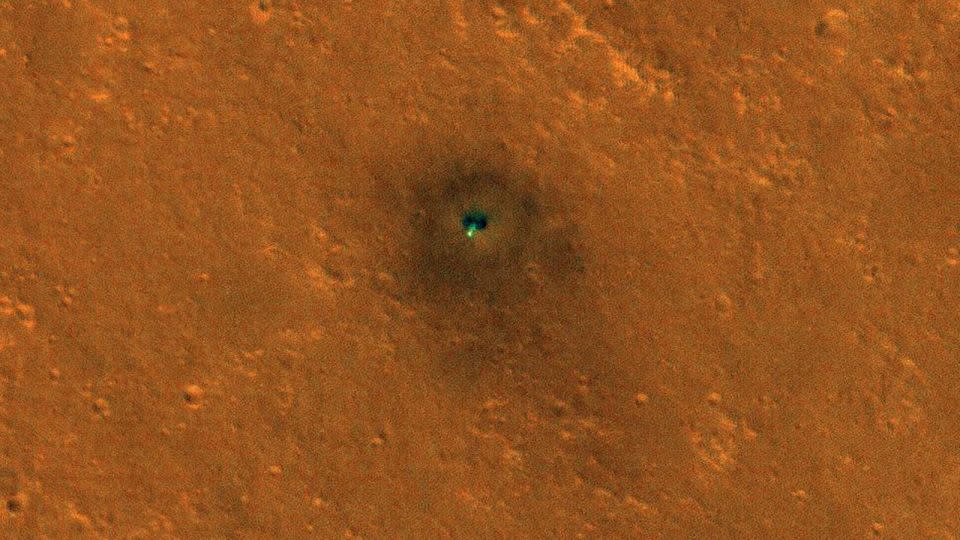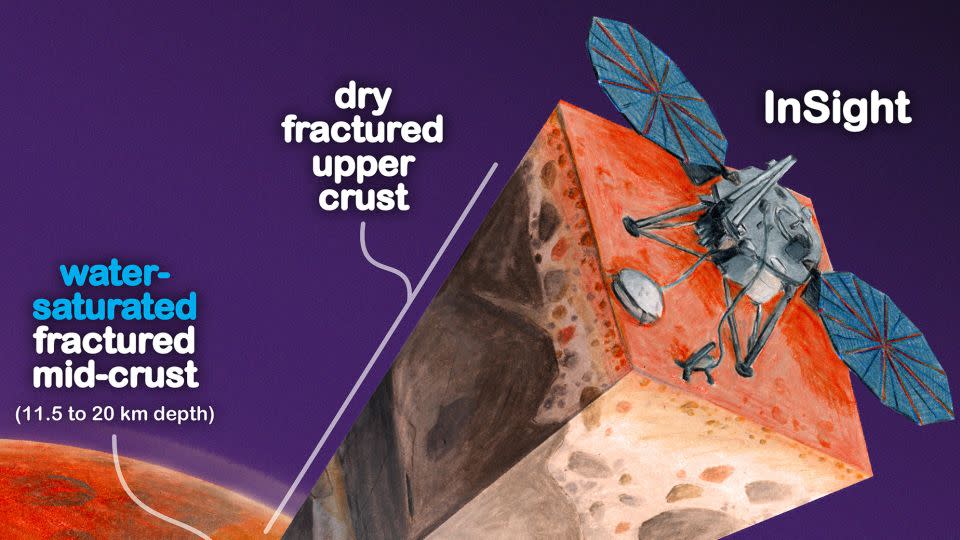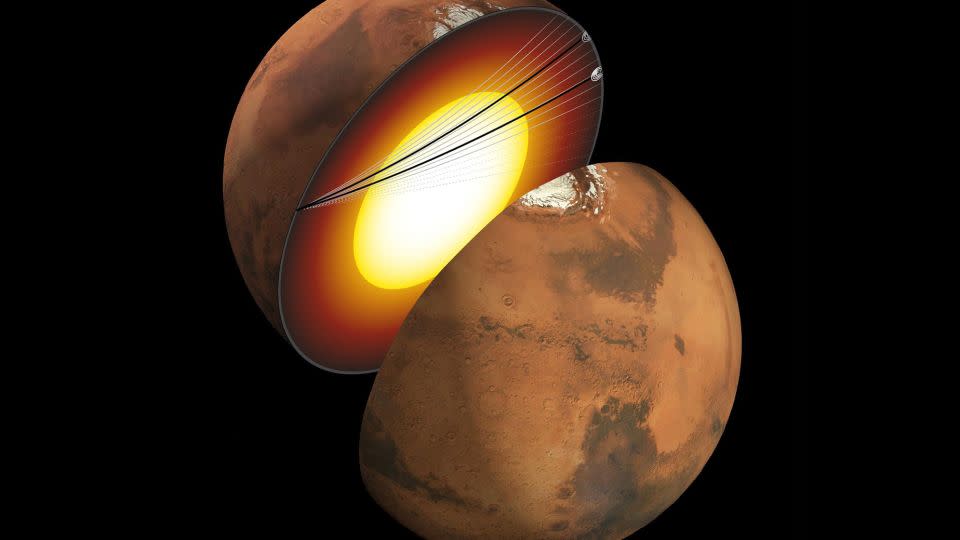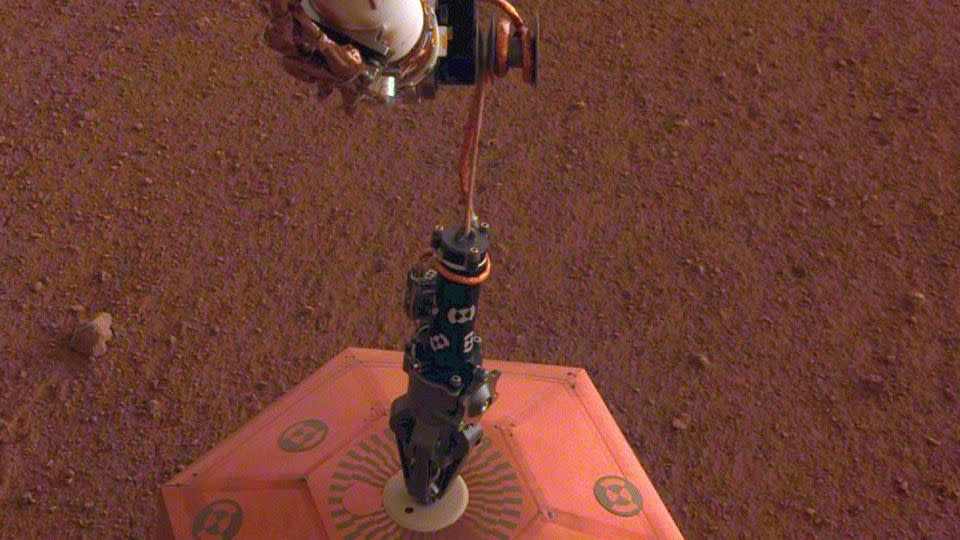Sign up for CNN’s Wonder Theory science newsletter. Explore the universe with news about fascinating discoveries, scientific advances and more.
Data from a retired NASA mission has revealed evidence of underground water reserves deep beneath the Martian surface, according to a new study.
A team of scientists estimates that there could be enough water trapped in tiny cracks and pores in the rock at the center of the Martian crust to fill the oceans on the planet’s surface. The study found that groundwater would likely cover the entirety of Mars to a depth of 1 mile (1.6 kilometers).
The data came from NASA’s InSight lander, which used seismometers to study the interior of Mars between 2018 and 2022.
Future astronauts exploring Mars will face a number of challenges if they try to reach water because it lies 7 to 12 miles (11.5 to 20 kilometers) below the surface, according to the study published Monday in the journal Proceedings of the National Academy of Sciences.
But the finding does reveal new details about Mars’ geological past and suggests a new place to look for life on the red planet, if water can be accessed.

“Understanding the Martian water cycle is critical to understanding the evolution of the climate, surface, and interior,” lead study author Vashan Wright, an assistant professor and geophysicist at the Scripps Institution of Oceanography at the University of California, San Diego, said in a statement. “A useful starting point is to determine where there is water and how much of it there is.”
Search for ‘lost’ water on Mars
Based on evidence of ancient lakes, river channels, deltas, and water-altered rocks studied by other NASA missions and observed by orbiters, Mars was likely a warmer, wetter place billions of years ago. But the red planet lost its atmosphere more than 3 billion years ago, effectively ending the wet period on Mars.
Scientists are still not sure why Mars lost its atmosphere, and a number of missions have been developed to learn about the history of the planet’s water, where it went, and whether the water created habitable conditions for life on Mars. While the water remains trapped as ice in the planet’s polar ice caps, researchers do not believe this can explain all of the planet’s “lost” water.
Current theories offer several possible scenarios for what happened to Martian water after Mars lost its atmosphere: Some assume it turned to ice or was lost to space, while others suggest the water mixed with minerals below the planet’s surface or seeped into deep aquifers.
New findings suggest that water on Mars seeps deep into the Martian crust.
InSight, short for Interior Exploration Using Seismic Investigation, Geodesy, and Thermal Transport, was a stationary lander. But it collected unprecedented data on the thickness of the Red Planet’s crust and the temperature of its mantle, as well as the depth and composition of its core and atmosphere. The lander’s seismometer detected the first earthquakes on another planet, called marsquakes.
Earthquakes occur when tectonic plates shift, move, and rub against each other, while the Martian crust is like a giant plate, riddled with faults and cracks as the planet continues to shrink and cool over time. The Martian crust cracks as it stretches, and InSight’s seismometer was able to detect more than 1,300 Marsquakes coming from hundreds and thousands of miles away.
By examining InSight’s data, scientists were able to study the speed of marsquakes as they passed through the planet, which could serve as an indicator of what material exists beneath the Martian surface.
The speed of seismic waves depends on what the rock is made of, where the cracks are and what fills those cracks, Wright said.
The team used this data to feed it into a mathematical model of rock physics used to map underground oil fields and aquifers on Earth.
The results showed that InSight’s data best matched a deep layer of igneous, or volcanic, rock filled with liquid water.


“The detection of a large reservoir of liquid water provides some insight into what the climate was or could have been like,” study co-author Michael Manga, a professor of Earth and planetary science at the University of California, Berkeley, said in a statement.
“And water is essential for life as we know it. I don’t understand why (the underground reservoir) wouldn’t be a habitable environment,” Manga added. “It’s certainly true on Earth — deep, deep mines host life, the bottom of the ocean hosts life. We haven’t found any evidence for life on Mars, but we’ve identified a place that could at least in principle sustain life.”
If Mars’ crust is similar throughout the planet, the authors wrote, there could be more water in the mid-crustal region than “the volumes suggested to have filled the putative ancient Martian oceans.”
Rocks help glean information about a planet’s history, and understanding a planet’s water cycle could help researchers unravel the evolution of Mars, Wright said.
Although analysis of the data could not reveal any information about past or present life on Mars, if life exists, it is possible that the wet Martian crust is hospitable to life in the same way that deep groundwater on Earth is hospitable to microbial life, he said.
But even drilling just half a mile (1 kilometer) or deeper on Earth is a challenge that requires energy and infrastructure, so drilling to those depths would require bringing a lot of resources to Mars, Wright said.


The team was surprised to find no evidence of frozen groundwater beneath Insight, because that part of the crust is cold. The researchers are still trying to determine why there is no frozen groundwater at shallower depths above the middle crust.
Windows into Mars history
The findings add another piece to the puzzle of water on Mars.
The idea that liquid water could exist deep below the Martian surface has been floating around for decades, but this is the first time that real data from a Mars mission has confirmed such speculation, said Alberto Fairén, a visiting interdisciplinary planetary scientist and astrobiologist in Cornell University’s department of astronomy. Fairén, who was not involved in the study, was not involved in the work.
He said the water was likely “some kind of deep underground mud.”
“These new results show that liquid water exists in the Martian subsurface today, not in the form of discrete and isolated lakes, but in the form of sediments or aquifers saturated with liquid water,” Fairén said. “On Earth, the subsurface biosphere is indeed very extensive and contains most of the prokaryotic diversity and biomass on our planet. Some studies point to an origin of life on Earth deep underground. So the astrobiological implications of finally confirming the existence of liquid water habitats many kilometers below the surface of Mars are really exciting.”


“The result is exactly what I was hoping to get from InSight,” said Bruce Banerdt, principal investigator of the InSight mission.
“I was hoping that we would get good enough data to do these kinds of studies where we look at the details of the Martian interior that relate to geological questions, questions about the habitability of Mars, questions about the evolution of Mars,” he said.
Banerdt, who was not involved in the research, said that while the interpretation of the data presented in the paper is supported by strong arguments, he believes it is still somewhat speculative and that there is almost always another way to explain any data set.
“I was really impressed by how Wright and others used mineral physics concepts to interpret seismic data,” Banerdt said.
Banerdt and Wright expressed interest in the ability to send more seismometers to Mars and other planets and moons in our solar system in the future. While InSight’s one seismometer will collect important data, deploying them to Mars will reveal changes in the planet’s interior and provide a greater window into its diverse and complex past, Banerdt said.
“Just as it is on Earth, where groundwater is connected to the surface via rivers and lakes, this was certainly the case on early Mars,” Wright said. “The groundwater we see is a record of that past.”
For more CNN news and bulletins, create an account at CNN.com